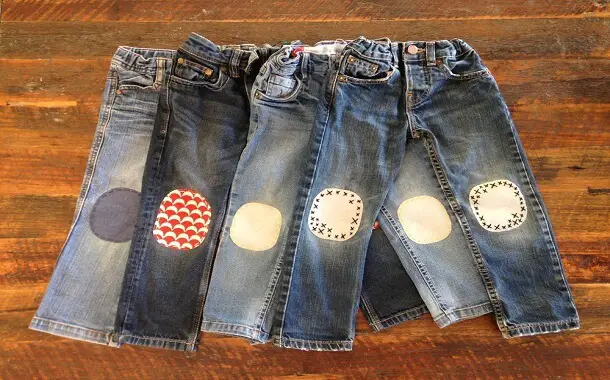How Much Does It Cost to Get Patches Sewn On?
Last Updated on February 6, 2024
Written by CPA Alec Pow | Content Reviewed by ![]() CFA Alexander Popinker
CFA Alexander Popinker
Adding patches to clothing and textiles can serve many purposes, from fashion and style to identification and repair. Sewing custom patches or badges onto garments is a popular way to customize and personalize your clothes and accessories.
But how much should you expect to pay for professional patch application services or embroidery? Here’s an in-depth look at the costs, factors, and money-saving tips for getting patches professionally sewn on or doing it yourself.
How Much Does It Cost to Get Patches Sewn On?
The average price range for basic patch sewing is $3 to $15 per patch. However, prices can vary more widely based on the size and complexity of the patch design. Professional tailors and embroidery shops typically charge by the patch when applying standard or custom patches to garments and textiles.
Larger and more detailed patches will be on the more expensive end while smaller, simpler patches can be as cheap as $1 to sew on. Expect to pay around $5 per patch on average for uncomplicated designs like basic shape patches or patches under 3 inches wide.
Embroidery shops tend to charge higher rates than local tailors or seamstresses for patch application, with costs averaging between $10 and $15 per patch. But they offer a wider selection of patch designs and often higher quality results.
According to Reddit users, wholesale pricing is usually around $2-$4 to sew a patch, while regular pricing is $5+ depending on the shape.
Members from the PatternReview.com forum mentioned that local tailoring shops charge $5 for sewing on patches.
At Sewing by Penny, the price list indicates that sewing on large patches costs $7.00 per patch, while medium patches cost $5.00 per patch.
Factors Influencing the Cost of Sewing Patches
Several factors affect the price charged for sewing on a clothing patch, including:
- Type of patch: Custom designed patches cost more than pre-made standard patches. Handmade embroidered patches have the highest application fees.
- Fabric type: Patching sturdier materials like canvas or denim is simpler than sheer or delicate fabrics. Leather, suede and vinyl can be trickier and more labor intensive for sewing patches.
- Complexity: Intricate patches with dense stitching or applique details take more time and skill to apply, increasing the price.
- Size of patch: Larger patches usually cost more to attach than small patches. Oversized patches may require special handling.
- Professional vs. DIY: Hiring a tailor or embroidery shop is more expensive than DIY but ensures quality results.
How to Choose a Service for Sewing Patches
When selecting a tailor or embroidery shop for patch application, look for services with:
You might also like our articles about the cost of pant alterations, dress hemming, or tailoring.
- Good reputation and online reviews. Ask to see examples of their work.
- Experience sewing patches onto your specific fabric type.
- Competitive pricing for your budget. Get quotes from 3-5 providers.
- Quality workmanship and proper use of stabilizers, thread, and stitch techniques.
- Quick turnaround time if needed. Some shops have rush fees.
Shop around to find the best combination of price, experience, and service for your patching project.
DIY Patch Sewing: Costs and Tips
 Sewing patches on yourself can save money compared to hiring a professional. Here are some DIY patch sewing tips:
Sewing patches on yourself can save money compared to hiring a professional. Here are some DIY patch sewing tips:
- Supplies needed: patch, fabric, sewing machine or needle/thread, scissors, straight pins, iron.
- Prepare the garment and patch. Iron fabrics, trim loose threads, wash/clean as needed.
- Pin the patch in place. Check placement and alignment first.
- Thread your needle or sewing machine with strong, matching thread.
- Use tight, dense straight stitches 1⁄4” from the edge of the patch, removing pins as you go.
- Finish by knotting threads securely. Press with an iron to smooth.
DIY sewing costs are under $5 per patch for most simple designs. The main expenses are purchasing patches and basic sewing tools, though many households already own the necessary supplies. Learning to hand-sew or use a sewing machine takes practice but is very budget-friendly long-term.
Saving Money on Sewing Patches
Here are some tips for keeping your patching project affordable:
- Buy patches in bulk online or from wholesalers to get deep volume discounts.
- Ask your local tailor about possible discounts for sewing on multiple patches at once.
- Learn basic sewing skills to DIY your patches. Take a class if needed to get started.
- Use coupons and look for sales at craft and fabric stores for patching materials.
- Consider machine embroidery instead of hand sewing for large batches of identical patches.
- Repair old patches by simply re-stitching edges rather than replacing.
Conclusion
The cost to professionally sew on a clothing patch range widely based on the patch size, fabric, complexity and your local labor rates, but averages about $5 per patch. Simple DIY sewing can reduce the price to under $1 per patch with some practice.
Shop around, learn basic sewing skills, buy patches in bulk, and repair old patches to save the most money. With some creativity and research, you can customize any garment with patches without breaking the bank.
Frequently Asked Questions
How much does it cost to have patches sewn on a leather vest?
Sewing patches onto leather generally costs $5-$15 per patch depending on the patch size and complexity. Leather’s thick, stiff texture makes patch application more challenging and time-consuming. Expect to pay premium rates around $10-$15 per patch for leather items.
Can a sewn patch be removed?
Yes, sewn patches can be removed by carefully unpicking or cutting the stitching threads attaching it. However, removal risks damaging the underlying fabric.
Patches on delicate fabrics like silk may not be removable without harm. Leather may retain visible stitch holes. Removing patches is generally not recommended unless necessary.
Are patches cheaper than embroidery?
Yes, pre-made patches are usually much cheaper than custom embroidery, costing just $3-$15 per patch rather than $40 or more for embroidery.
Patches offer an affordable way to customize clothing. However, embroidery provides a smoother, integrated design instead of an overlay. Combined patches and embroidery offer the best of both at a moderate cost.


Leave a Reply
Want to join the discussion?Feel free to contribute!